Assessing Users’ Satisfaction with the Urban Central Metro Station Area in Chengdu: An SEM-IPA Approach
Abstract
1. Introduction
2. Theoretical Framework and Index
2.1. Theoretical Framework and Hypothesis
2.2. Index System
3. Method and Data
3.1. SEM-IPA Model
3.1.1. Structural Equation Model (SEM)
3.1.2. Importance–Performance Analysis (IPA)
3.1.3. SEM-IPA Method
3.2. Study Area and Data
3.3. Research Process
4. Results
4.1. Data Description
4.2. Reliability and Validity
4.3. Influence Path
4.4. Importance–Performance Alignment
5. Discussion and Conclusions
5.1. Discussion
5.1.1. Field Environment
5.1.2. Urban Aesthetics
5.1.3. Location Situation
5.2. Conclusions
Author Contributions
Funding
Data Availability Statement
Acknowledgments
Conflicts of Interest
References
- Choi, K.; Park, H.J.; Uribe, F.A. The impact of light rail transit station area development on residential property values in Calgary, Canada: Focus on land use diversity and activity opportunities. Case Stud. Transp. Pol. 2023, 12, 100924. [Google Scholar] [CrossRef]
- Papa, E.; Bertolini, L. Accessibility and Transit-Oriented Development in European metropolitan areas. J. Transp. Geogr. 2015, 47, 70–83. [Google Scholar] [CrossRef]
- Vale, D.S. Transit-oriented development, integration of land use and transport, and pedestrian accessibility: Combining node-place model with pedestrian shed ratio to evaluate and classify station areas in Lisbon. J. Transp. Geogr. 2015, 45, 70–80. [Google Scholar] [CrossRef]
- Yang, L.; Chen, Y.; Xu, N.; Zhao, R.; Chau, K.W.; Hong, S. Place-varying impacts of urban rail transit on property prices in Shenzhen, China: Insights for value capture. Sustain. Cities Soc. 2020, 58, 102140. [Google Scholar] [CrossRef]
- Mocak, P.; Matlovicova, K.; Matlovic, R.; Penzes, J.; Pachura, P.; Mishra, P.K.; Kostilnikova, K.; Demkova, M. 15-minute city concept as a sustainable urban development alternative: A brief outline of conceptual frameworks and slovak cities as a case. Folia Geogr.-Slovak 2022, 64, 69–89. [Google Scholar]
- Moreno, C.; Allam, Z.; Chabaud, D.; Gall, C.; Pratlong, F. Introducing the “15-Minute City”: Sustainability, Resilience and Place Identity in Future Post-Pandemic Cities. Smart Cities 2021, 4, 93–111. [Google Scholar] [CrossRef]
- Mondschein, A.; Moga, S.T. New Directions in Cognitive-Environmental Research. J. Am. Plan. Assoc. 2018, 84, 263–275. [Google Scholar] [CrossRef]
- Gao, Y.; Chen, Y.Y.; Mu, L.; Gong, S.Z.; Zhang, P.C.; Liu, Y. Measuring urban sentiments from social media data: A dual-polarity metric approach. J. Geogr. Syst. 2022, 24, 199–221. [Google Scholar] [CrossRef]
- Olaru, D.; Curtis, C. Designing TOD precincts: Accessibility and travel patterns. Eur. J. Transp. Infrastruct. Res. 2015, 15, 6–26. [Google Scholar] [CrossRef]
- Gao, W.; Sun, X.L.; Zhao, M.; Gao, Y.; Ding, H.R. Evaluate Human Perception of the Built Environment in the Metro Station Area. Land 2024, 13, 90. [Google Scholar] [CrossRef]
- Li, C.N.; Lin, C.; Hsieh, T.K. TOD District Planning Based on Residents’ Perspectives. ISPRS Int. J. Geo-Inf. 2016, 5, 52. [Google Scholar] [CrossRef]
- Chen, T.; Chen, Y.; Zhou, Y.; Guo, J. Efficiency Assessment of Transit-Oriented Development Focusing on the 500-m Core Catchment of Metro Stations Based on the Concept of a Metro Microcenter in Beijing. J. Transp. Eng. A-Syst. 2023, 149, 04023117. [Google Scholar] [CrossRef]
- Ma, J.X.; Shen, Z.W.; Xie, Y.; Liang, P.P.; Yu, B.J.; Chen, L. Node-place model extended by system support: Evaluation and classification of metro station areas in Tianfu new area of Chengdu. Front. Environ. Sci. 2022, 10, 990416. [Google Scholar] [CrossRef]
- Wu, W.J.; Chen, W.Y.; Yun, Y.W.; Wang, F.L.; Gong, Z.Y. Urban greenness, mixed land-use, and life satisfaction: Evidence from residential locations and workplace settings in Beijing. Landsc. Urban Plan. 2022, 224, 104428. [Google Scholar] [CrossRef]
- Lee, K.Y. Relationship between Physical Environment Satisfaction, Neighborhood Satisfaction, and Quality of Life in Gyeonggi, Korea. Land 2021, 10, 663. [Google Scholar] [CrossRef]
- Bivina, G.R.; Gupta, A.; Parida, M. Walk Accessibility to Metro Stations: An analysis based on Meso- or Micro-scale Built Environment Factors. Sustain. Cities Soc. 2020, 55, 102047. [Google Scholar] [CrossRef]
- Yang, L.; Yang, H.; Tang, J.; Lu, Y.; Liu, J. Assessing attribute performance and older adults’ satisfaction with transit services: Implications for age-friendly planning. Travel. Behav. Soc. 2025, 40, 101026. [Google Scholar] [CrossRef]
- Cervero, R.; Sarmiento, O.L.; Jacoby, E.; Gomez, L.F.; Neiman, A. Influences of Built Environments on Walking and Cycling: Lessons from Bogota. Int. J. Sustain. Transp. 2009, 3, 203–226. [Google Scholar] [CrossRef]
- Banerjee, I. Production of Railwayscape in urban environment: Analysing railway heritage tourism potential in Siliguri City, India. Reg. Sustain. 2023, 4, 1–12. [Google Scholar] [CrossRef]
- Bertolini, L. Nodes and places: Complexities of railway station redevelopment. Eur. Plan. Stud. 1996, 4, 331–345. [Google Scholar] [CrossRef]
- Cao, Z.; Asakura, Y.; Tan, Z. Coordination between node, place, and ridership: Comparing three transit operators in Tokyo. Transp. Res. Part D Transp. Environ. 2020, 87, 102518. [Google Scholar] [CrossRef]
- Deng, X.D.; Zhang, J.; Liao, S.Y.; Zhong, C.J.; Gao, F.; Teng, L. Interactive Impacts of Built Environment Factors on Metro Ridership Using GeoDetector: From the Perspective of TOD. ISPRS Int. J. Geo-Inf. 2022, 11, 623. [Google Scholar] [CrossRef]
- Cao, J.; Ettema, D. Satisfaction with travel and residential self-selection: How do preferences moderate the impact of the Hiawatha Light Rail Transit line? J. Transp. Land. Use 2014, 7, 93–108. [Google Scholar] [CrossRef]
- Huang, X.; Yuan, W.; White, M.; Langenheim, N. A Parametric Framework to Assess Generative Urban Design Proposals for Transit-Oriented Development. Buildings 2022, 12, 1971. [Google Scholar] [CrossRef]
- Zhengyu, D.; Xuan, H.; Chuan, C. The Impacts of Urban Residential Location and Travel Behavior on Commuters’ Quality of Life: A Case Study of Shanghai, China. Mod. Urban Res. 2023, 88–93. [Google Scholar] [CrossRef]
- Junyan, Y.; Yi, S. Research on spatial location mechanism and layout methods of urban district-wide center. City Plan. Rev. 2018, 1, 43–51. [Google Scholar]
- Aghaabbasi, M.; Moeinaddini, M.; Shah, M.Z.; Asadi-Shekari, Z.; Kermani, M.A. Evaluating the capability of walkability audit tools for assessing sidewalks. Sustain. Cities Soc. 2018, 37, 475–484. [Google Scholar] [CrossRef]
- Lynch, K. Lynch Image of the City; The MIT Press: Cambridge, MA, USA, 1960. [Google Scholar]
- Cho, G.H.; Rodriguez, D. Location or design? Associations between neighbourhood location, built environment and walking. Urban Stud. 2015, 52, 1434–1453. [Google Scholar] [CrossRef]
- Yin, C.H.; Liu, Y.F.; Wei, X.J.; Chen, W.Q. Road Centrality and Urban Landscape Patterns in Wuhan City, China. J. Urban Plan. Dev. 2018, 144, 05018009. [Google Scholar] [CrossRef]
- Torquati, B.; Giacchè, G.; Tempesta, T. Landscapes and Services in Peri-Urban Areas and Choice of Housing Location: An Application of Discrete Choice Experiments. Land 2020, 9, 393. [Google Scholar] [CrossRef]
- Yang, L.; Wang, X.; Sun, G.; Li, Y. Modeling the perception of walking environmental quality in a traffic-free tourist destination. J. Travel. Tour. Mark. 2020, 37, 608–623. [Google Scholar] [CrossRef]
- Cetintahra, G.E.; Cubukcu, E. The influence of environmental aesthetics on economic value of housing: An empirical research on virtual environments. J. Hous. Built Environ. 2015, 30, 331–340. [Google Scholar] [CrossRef]
- Fu, Y.; Zhang, X.L. Trajectory of urban sustainability concepts: A 35-year bibliometric analysis. Cities 2017, 60, 113–123. [Google Scholar] [CrossRef]
- Julsrud, T.E.; Uteng, T.P. Technopolis, shared resources or controlled mobility? A net-based Delphi-study to explore visions of future urban daily mobility in Norway. Eur. J. Futures Res. 2015, 3, 1–13. [Google Scholar] [CrossRef]
- Allen, J.; Eboli, L.; Forciniti, C.; Mazzulla, G.; de Dios Ortuzar, J. The role of critical incidents and involvement in transit satisfaction and loyalty. Transp. Policy 2019, 75, 57–69. [Google Scholar] [CrossRef]
- Arbore, A.; Busacca, B. Rejuvenating importance-performance analysis. J. Serv. Manag. 2011, 22, 409–430. [Google Scholar] [CrossRef]
- Rasovska, I.; Kubickova, M.; Ryglova, K. Importance-performance analysis approach to destination management. Tour. Econ. 2021, 27, 777–794. [Google Scholar] [CrossRef]
- Ban, O.I.; Ban, A.I.; Tuşe, D.A. Importance–Performance Analysis by Fuzzy C-Means Algorithm. Expert. Syst. Appl. 2016, 50, 9–16. [Google Scholar] [CrossRef]
- Martilla, J.A.; James, J.C. Importance-performance analysis. J. Mark. 1977, 1, 77–79. [Google Scholar] [CrossRef]
- Kuby, M.; Barranda, A.; Upchurch, C. Factors influencing light-rail station boardings in the United States. Transp. Res. Part A Policy Pract. 2004, 38, 223–247. [Google Scholar] [CrossRef]
- O’Sullivan, S.; Morrall, J. Walking Distances to and from Light-Rail Transit Stations. Transp. Res. Rec. J. Transp. Res. Board. 1996, 1538, 19–26. [Google Scholar] [CrossRef]
- Field, A. Discovering Statistics Using SPSS for Windows: Advanced Techniques for Beginners; Springer: New York, NY, USA, 2000. [Google Scholar]
- Hair, J.; Black, W.; Babin, B.; Anderson, R. Multivariate Data Analysis; Prentice Hall: Upper Saddle River, NJ, USA, 2009. [Google Scholar]
- Wu, M. Questionnaire Statistical Analysis: SPSS Operation and Application; Chongqing University Press: Chongqing, China, 2010. [Google Scholar]
- Hair, J.; Black, W.; Babin, B.; Anderson, R. Multivariate Data Analysis, 6th ed.; Prentice Hall: Upper Saddle River, NJ, USA, 2006. [Google Scholar]
- Ong, A.K.S.; Prasetyo, Y.T.; Lagura, F.C.; Sigua, K.M.; Villas, J.A.; Nadlifatin, R.; Young, M.N.; Diaz, J.F.T. Determining tricycle service quality and satisfaction in the Philippine urban areas: A SERVQUAL approach. Cities 2023, 137, 104339. [Google Scholar] [CrossRef]
- Steiger, J.H. Understanding the limitations of global fit assessment in structural equation modeling. Personal. Individ. Differ. 2007, 42, 893–898. [Google Scholar] [CrossRef]
- Gefen, D.; Straub, D.W.; Boudreau, M. Structural Equation Modeling and Regression: Guidelines for Research Practice. Commun. Assoc. Inf. Syst. 2000, 4, 7. [Google Scholar] [CrossRef]
- Hair, J.F. Multivariate Data Analysis with Readings; Macmillan, Collier Macmillan: New York, NY, USA, 1987. [Google Scholar]
- Nematollahi, S.; Tiwari, R.; Hedgecock, D. Desirable Dense Neighbourhoods: An Environmental Psychological Approach for Understanding Community Resistance to Densification. Urban Policy Res. 2015, 34, 132–151. [Google Scholar] [CrossRef]
- Dai, P.; Fu, H.; Yang, X.X.; Han, S.; Fu, G.N.; Wang, Y.J. Exploring the urban renewal strategy based on transit-oriented development concept--A case study of Japan and Hong Kong. Front. Mater. 2023, 10, 1098027. [Google Scholar] [CrossRef]
- Sung, H.; Lee, S.; Jung, S. Identifying the relationship between the objectively measured built environment and walking activity in the high-density and transit-oriented city, Seoul, Korea. Environ. Plan. B-Plan. Des. 2014, 41, 637–660. [Google Scholar] [CrossRef]
- Liang, X.; Lu, Z.R.; Ye, F.; Zhang, W.J. Investigation of design of independent metro station entrances in China. Proc. Inst. Civ. Eng.-Munic. Eng. 2023, 176, 10–31. [Google Scholar] [CrossRef]
- Zhao, J.J.; Dong, J.K.; Zhang, X.H.; Na, Y.L.; Jiang, C.X.; He, F.; Cui, Q.J.; Liu, J. Field measurement of microclimate of sunken square and its effect on indoor environment of underground metro station in subtropical region. Build. Environ. 2023, 228, 109873. [Google Scholar] [CrossRef]
- Li, Z.; Lin, X.S.; Han, X.; Lu, X.Y.; Zhao, H.Y. Landscape Efficiency Assessment of Urban Subway Station Entrance Based on Structural Equation Model: Case Study of Main Urban Area of Nanjing. Buildings 2022, 12, 294. [Google Scholar] [CrossRef]
- Garza-Rodríguez, F. Identifying cultural clusters in Monterrey city center. A Case study. Contexto-Rev. Fac. Arq. 2019, 13, 41–56. [Google Scholar]
- Mateo-Babiano, I. Pedestrian’s needs matter: Examining Manila’s walking environment. Transp. Policy 2016, 45, 107–115. [Google Scholar] [CrossRef]
- Yang, L.; Yang, H.; Yu, B.; Lu, Y.; Cui, J.; Lin, D. Exploring non-linear and synergistic effects of green spaces on active travel using crowdsourced data and interpretable machine learning. Travel. Behav. Soc. 2024, 34, 100673. [Google Scholar] [CrossRef]
- Portnov, B.A.; Schwartz, M. On the Importance of the ‘Location Package’ for Urban Growth. Urban Stud. 2009, 46, 1665–1679. [Google Scholar] [CrossRef]
- Yang, L.; Lu, Y.; Cao, M.; Wang, R.; Chen, J. Assessing accessibility to peri-urban parks considering supply, demand, and traffic conditions. Landsc. Urban Plan. 2025, 257, 105313. [Google Scholar] [CrossRef]
- Peng, P.P.; Liu, Z.; Guo, J.H.; Wang, C. Dynamic Metro Stations Importance Evaluation Based on Network Topology and Real-Time Passenger Flows. Ksce J. Civ. Eng. 2023, 27, 4459–4471. [Google Scholar] [CrossRef]
- Liu, Q.; Qian, Z.; Lai, Y. Transit Oriented Shrinkage: Planning Methods of Location Optimization Plan in Japan from the Perspective of TOD. Urban. Plan. Int. 2023, 38, 112–122, 144. [Google Scholar]
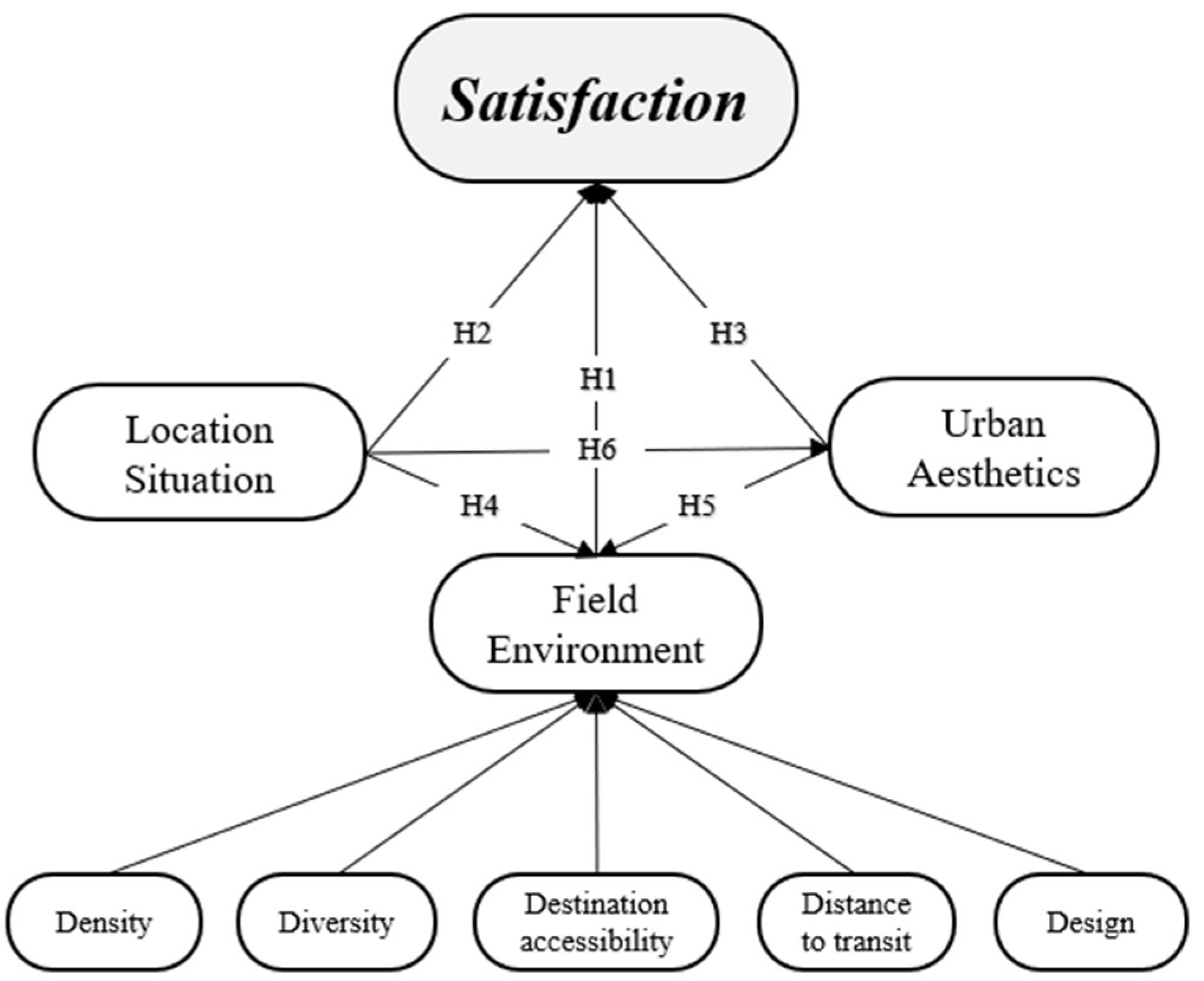
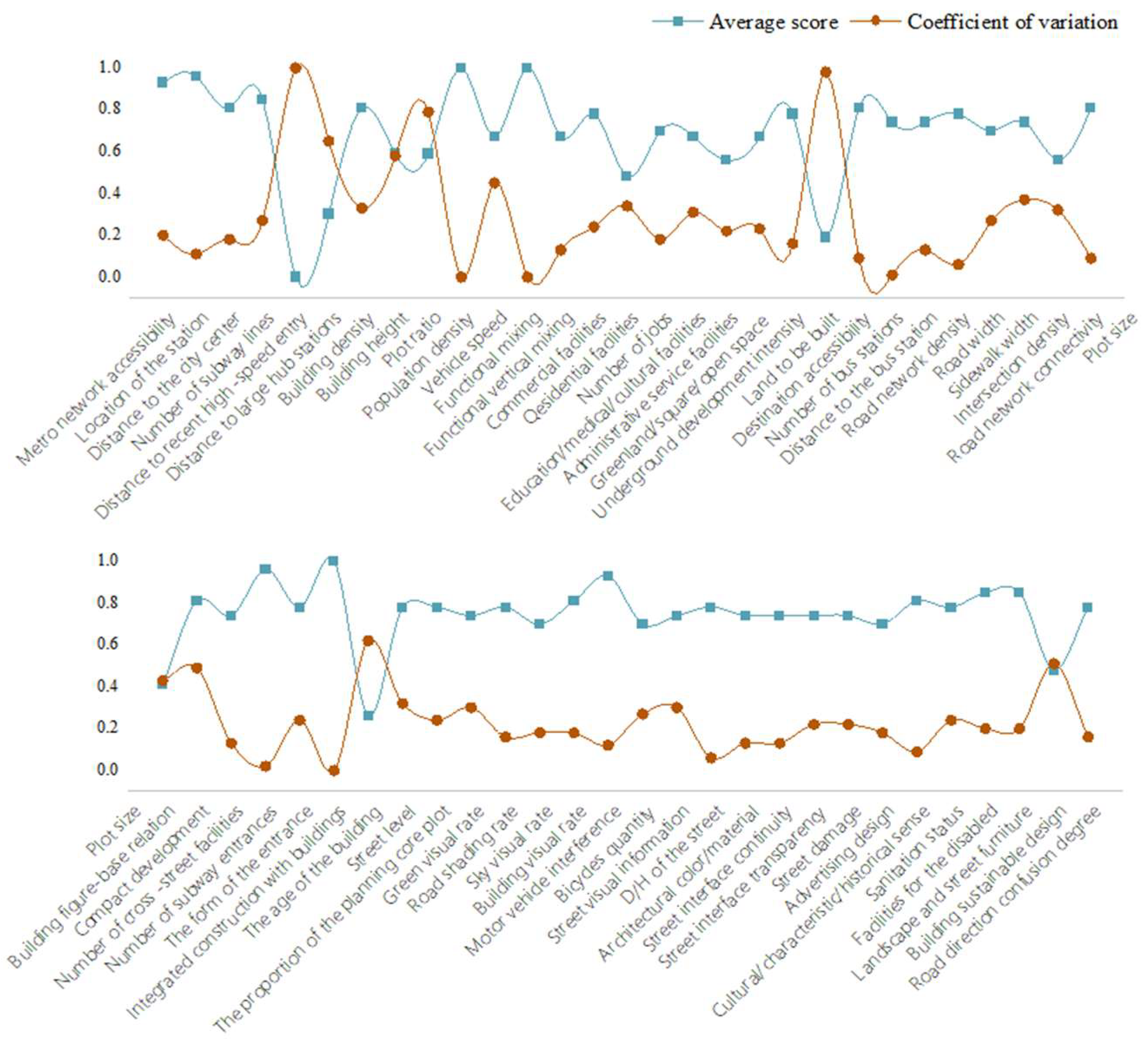

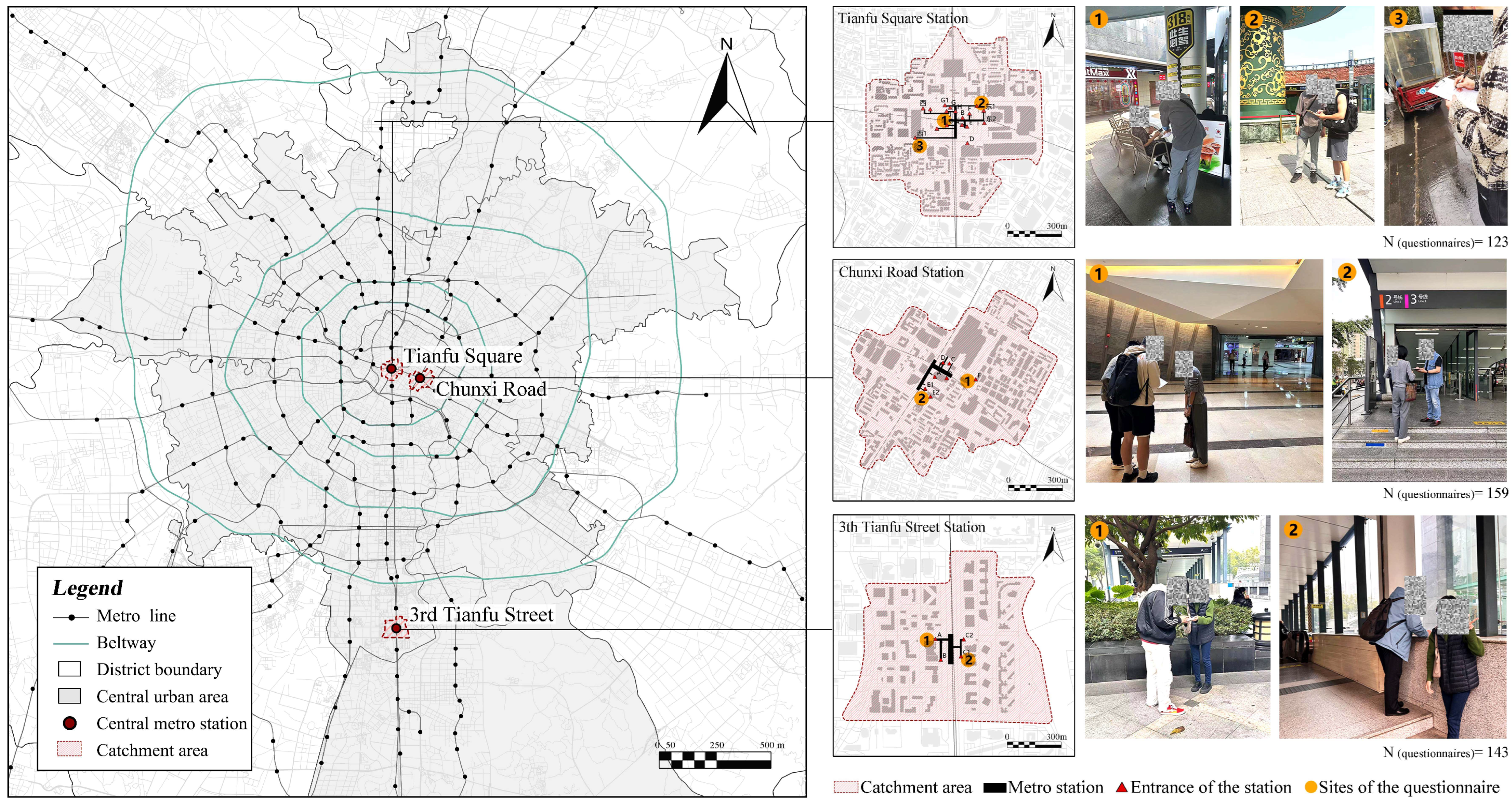
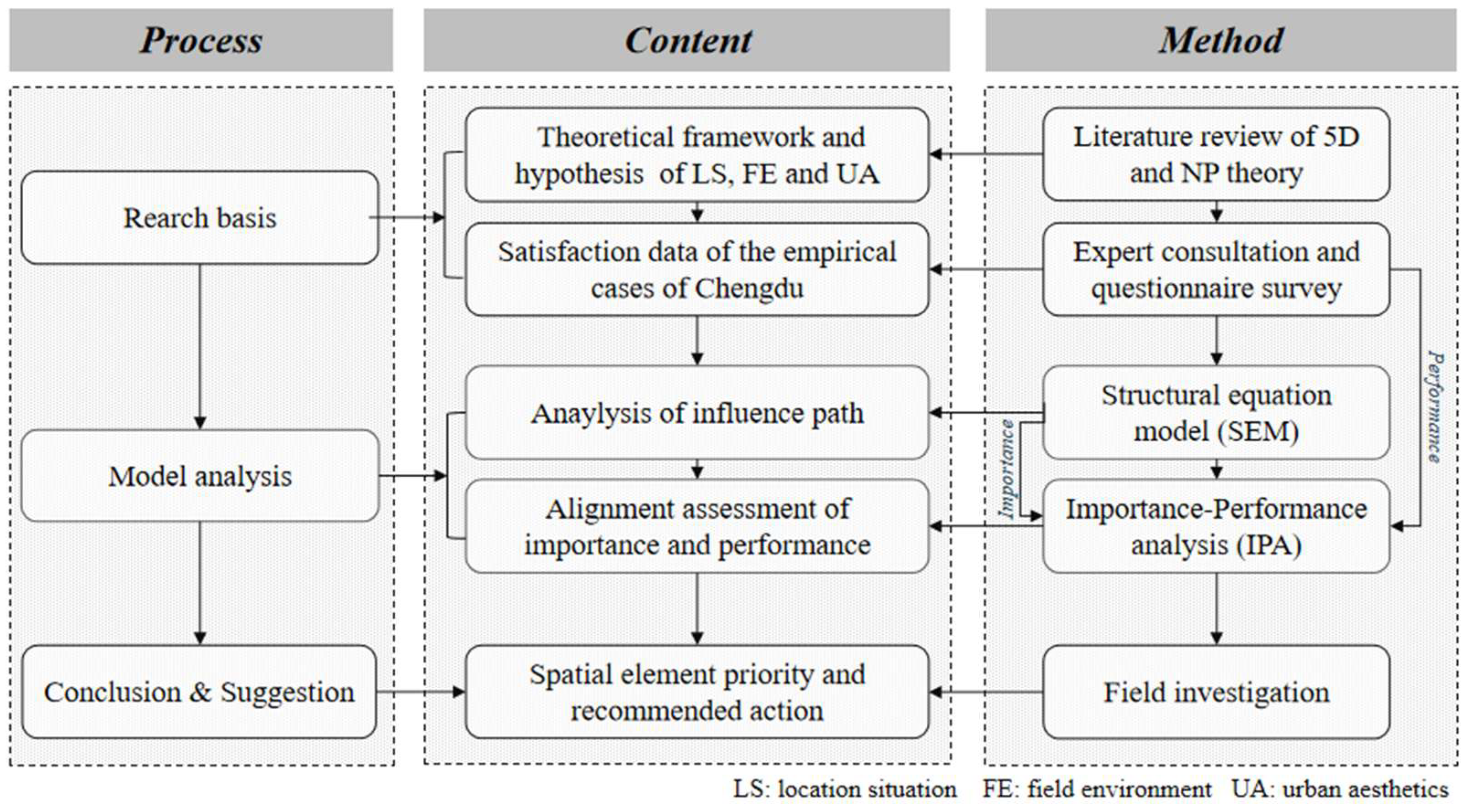
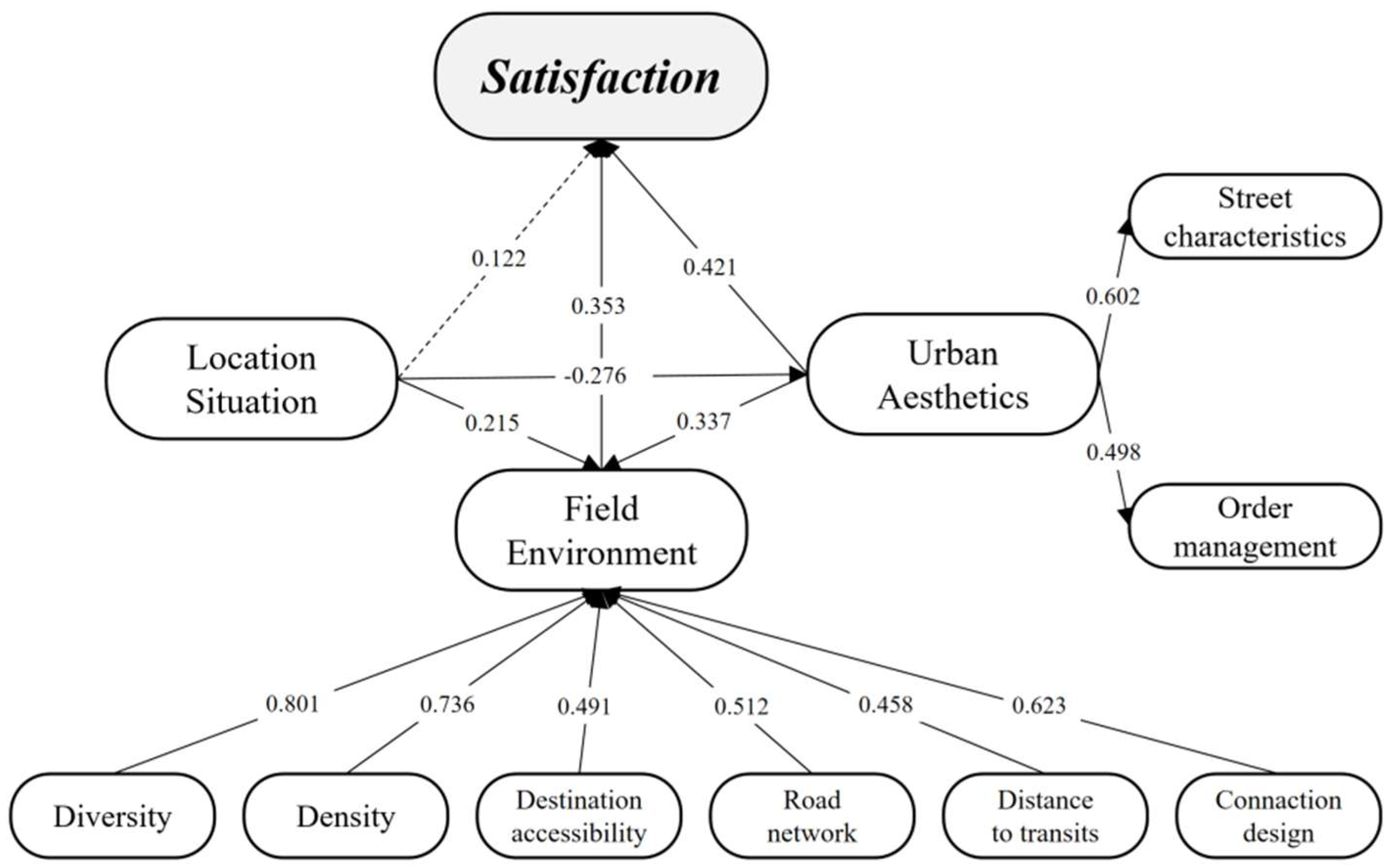

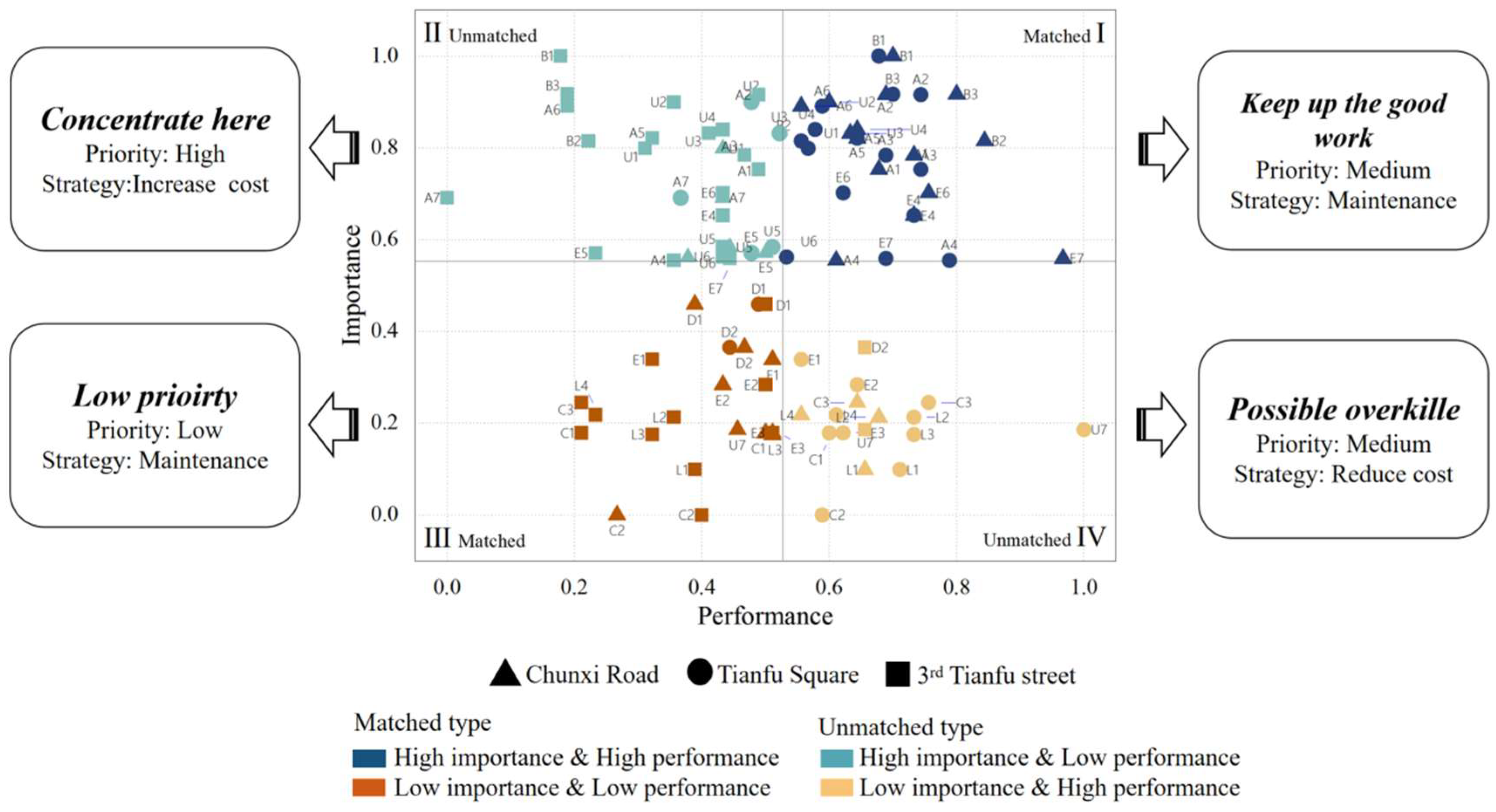
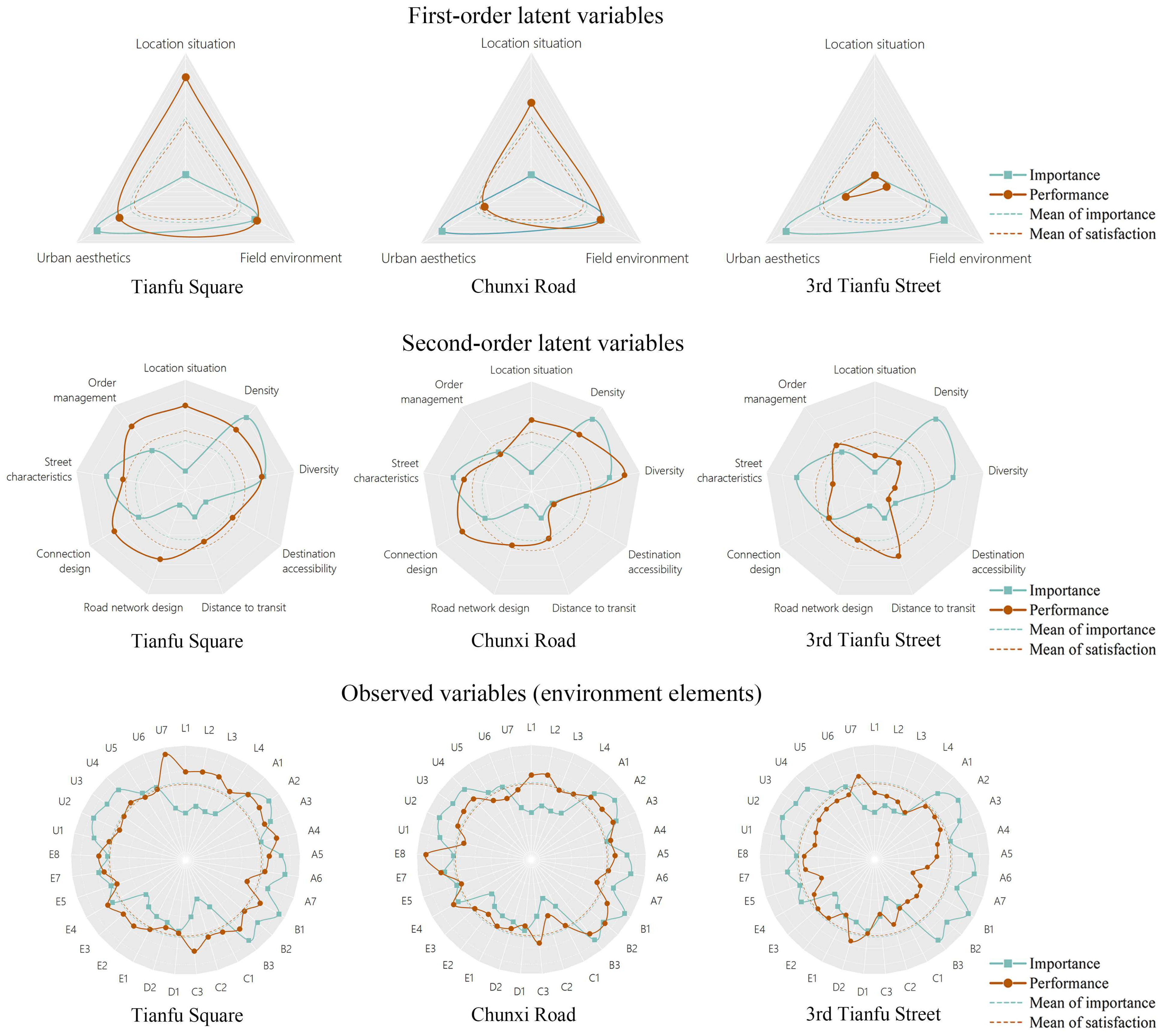
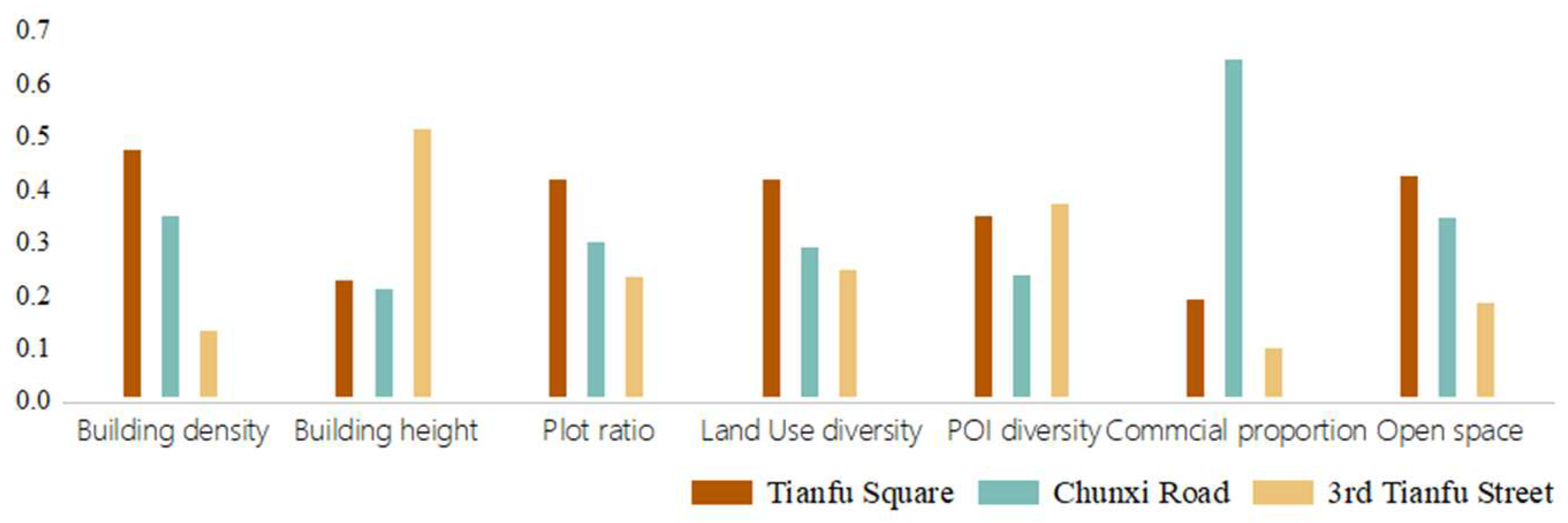


| Hypothesis | Description | Reference |
|---|---|---|
| H1 | Field environment directly affects satisfaction | [14,23,24] |
| H2 | Location situation directly affects satisfaction | [25,26] |
| H3 | Urban aesthetics directly affects satisfaction | [14,27,28] |
| H4 | Location situation affects field environment | [29] |
| H5 | Location situation affects urban aesthetics | [30,31] |
| H6 | Urban aesthetics affects field environment | [32,33] |
| Dimension | 1st-Order Index | 2nd-Order Index |
|---|---|---|
| Location Situation | / | L1. Location in the city |
| L2. The rationality of subway line planning | ||
| L3. Number of subway lines | ||
| L4. Accessibility to other centers | ||
| Field Environment | Density | A1. Development intensity |
| A2. Building volume | ||
| A3. Underground space development intensity | ||
| A4. Adequacy of open space | ||
| A5. Crowdedness | ||
| A6. Traffic jam | ||
| A7. The interference between people and vehicles | ||
| Diversity | B1. Satisfaction of basic needs | |
| B2. Adequacy of function selection | ||
| B3. The rationality of function ratio | ||
| Destination accessibility | C1. Accessibility of commercial facilities | |
| C2. Accessibility of official facilities | ||
| C3. Accessibility of residential facilities | ||
| C4. Accessibility of public service facilities | ||
| Distance to transit | D1. The convenience of the bus transfer | |
| D2. The convenience of the bicycle transfer | ||
| Design | E1. Road connectivity | |
| E2. Road directivity | ||
| E3. The convenience of getting to the destination | ||
| E4. Entrance quantity | ||
| E5. Entrance location | ||
| E6. Degree of difficulty of finding entrance | ||
| E7. Form of entrance | ||
| E8. Entrance connection with building | ||
| Urban Aesthetics | / | U1. Proportion and scale of the street |
| U2. Color and style of the street | ||
| U3. Street furniture | ||
| U4. Culture of the street | ||
| U5. Street hygiene | ||
| U6. Landscape maintenance | ||
| U7. Perceived safety |
| Personal Particulars | Item | Percent (%) | Personal Particulars | Item | Percent (%) |
|---|---|---|---|---|---|
| Gender | Male | 47.29 | Purpose of visit | Transfer | 1.65 |
| Female | 52.71 | Shopping | 15.06 | ||
| Age | <30 | 50.82 | Work | 33.65 | |
| ≥30 | 49.18 | Residence | 7.06 | ||
| Education | Sub-bachelor’s | 56.94 | Affairs | 32.94 | |
| Bachelor’s degree or above | 43.06 | Travel | 5.42 | ||
| Professional relevance | Unrelated | 74.82 | Others | 4.22 | |
| Relevant | 25.18 | ||||
| Visiting frequency | <2 times/month | 43.53 | |||
| 3–4 times/month | 33.88 | ||||
| Almost every day | 22.59 |
| Latent Variable | Cronbach’s Alpha | Latent Variable | Cronbach’s Alpha |
|---|---|---|---|
| Location situation | 0.825 | Distance to transit | 0.835 |
| Density | 0.872 | Design | 0.763 |
| Diversity | 0.875 | Urban aesthetics | 0.801 |
| Destination accessibility | 0.720 | Satisfaction | 0.858 |
| KMO Measure of Sampling Adequacy | 0.847 | |
|---|---|---|
| Bartlett Test of Sphericity | Approximate Chi-Square | 6977.882 |
| df | 561 | |
| Sig. | 0.000 | |
| Factors | Total | % of Variance | Cumulative % | Total | % of Variance | Cumulative % | Total | % of Variance | Cumulative % |
|---|---|---|---|---|---|---|---|---|---|
| 1 | 7.435 | 21.867 | 21.867 | 7.435 | 21.867 | 21.867 | 4.207 | 12.372 | 12.372 |
| 2 | 3.586 | 10.547 | 32.414 | 3.586 | 10.547 | 32.414 | 3.056 | 8.987 | 21.359 |
| 3 | 2.503 | 7.362 | 39.776 | 2.503 | 7.362 | 39.776 | 2.983 | 8.773 | 30.133 |
| 4 | 2.145 | 6.31 | 46.086 | 2.145 | 6.31 | 46.086 | 2.679 | 7.88 | 38.013 |
| 5 | 1.826 | 5.371 | 51.457 | 1.826 | 5.371 | 51.457 | 2.447 | 7.197 | 45.21 |
| 6 | 1.753 | 5.157 | 56.614 | 1.753 | 5.157 | 56.614 | 2.259 | 6.644 | 51.853 |
| 7 | 1.612 | 4.741 | 61.355 | 1.612 | 4.741 | 61.355 | 2.069 | 6.086 | 57.94 |
| 8 | 1.338 | 3.937 | 65.291 | 1.338 | 3.937 | 65.291 | 1.965 | 5.778 | 63.718 |
| 9 | 1.266 | 3.723 | 69.014 | 1.266 | 3.723 | 69.014 | 1.801 | 5.297 | 69.014 |
| Component | Factor Loading | ||||
|---|---|---|---|---|---|
| 1 | Density | A1/0.576 | A2/0.715 | A3/0.710 | A4/0.669 |
| A5/0.761 | A6/0.806 | A7/0.728 | |||
| 2 | Connection design | E4/0.797 | E5/0.806 | E7/0.857 | E8/0.830 |
| 3 | Location situation | L1/0.783 | L2/0.796 | L3/0.830 | L4/0.795 |
| 4 | Urban characteristics | U1/0.823 | U2/0.859 | U3/0.837 | U4/0.842 |
| 5 | Diversity | B1/0.762 | B2/0.801 | B3/0.814 | |
| 6 | Order management | U5/0.845 | U6/0.830 | U7/0.737 | |
| 7 | Road network design | E1/0.859 | E2/0.879 | E3/0.838 | |
| 8 | Destination accessibility | C1/0.804 | C2/0.732 | C4/0.781 | |
| 9 | Distance to transit | D1/0.871 | D2/0.859 | ||
| Hypothesis | Path | C.R. | Result |
|---|---|---|---|
| H1 | Field environment—>Satisfaction | 4.789 *** | True |
| H2 | Location situation—>Satisfaction | 0.069 | False |
| H3 | Urban aesthetics—>Satisfaction | 3.242 ** | True |
| H4 | Location situation—>Field environment | 3.006 ** | True |
| H5 | Location situation—>Urban aesthetics | −3.151 ** | True |
| H6 | Urban aesthetics—>Field environment | 2.932 ** | True |
| Goodness of Fit Measures | IFI | CFI | GFI | AGFI | x2/df | RMSEA |
|---|---|---|---|---|---|---|
| Parameter estimates | 0.949 | 0.948 | 0.890 | 0.874 | 1.654 | 0.039 |
| Minimum cut-off | >0.80 | >0.80 | >0.80 | >0.80 | 1~3 | <0.07 |
| Observed Variable | Latent Variable | Estimate | AVE | CR | Observed Variable | Latent Variable | Estimate | AVE | CR |
|---|---|---|---|---|---|---|---|---|---|
| L4 | Location Situation | 0.769 | 0.542 | 0.827 | D2 | Distance to transit | 0.814 | 0.719 | 0.837 |
| L3 | 0.736 | D1 | 0.881 | ||||||
| L2 | 0.765 | E3 | Road network design | 0.763 | 0.698 | 0.873 | |||
| L1 | 0.677 | E2 | 0.847 | ||||||
| A7 | Density | 0.667 | 0.485 | 0.874 | E1 | 0.891 | |||
| A6 | 0.758 | E7 | Connection design | 0.781 | 0.670 | 0.89 | |||
| A5 | 0.726 | E6 | 0.865 | ||||||
| A4 | 0.605 | E5 | 0.788 | ||||||
| A3 | 0.709 | E4 | 0.836 | ||||||
| A2 | 0.769 | U1 | Urban characteristics | 0.78 | 0.643 | 0.878 | |||
| A1 | 0.695 | U2 | 0.83 | ||||||
| B3 | Diversity | 0.84 | 0.701 | 0.876 | U3 | 0.796 | |||
| B2 | 0.789 | U4 | 0.8 | ||||||
| B1 | 0.881 | U5 | Order management | 0.804 | 0.532 | 0.769 | |||
| C3 | Destination accessibility | 0.758 | 0.470 | 0.724 | U6 | 0.791 | |||
| C2 | 0.576 | U7 | 0.569 | ||||||
| C1 | 0.709 |
| Independent Variable | Dependent Variable | Direct Effect | Indirect Effect | Total Effect |
|---|---|---|---|---|
| Field environment | Satisfaction | 0.399 | / | 0.399 |
| Location situation | / | −0.023 | −0.023 | |
| Urban aesthetics | 0.336 | 0.126 | 0.462 | |
| Location situation | Field environment | 0.206 | −0.072 | 0.134 |
| Location situation | Urban aesthetics | −0.228 | / | 0.228 |
| Urban aesthetics | Field environment | 0.316 | / | 0.316 |
| Station | First Quadrant | Second Quadrant | Third Quadrant | Fourth Quadrant |
|---|---|---|---|---|
| Tianfu Square | A1, A2, A3, A4, A5, A6, B1, B2, B3, E4, E6, E7, U1, U4, U6 | A7, E5, U2, U3, U5 | D1, D2 | L1, L2, L3, L4, C1, C2, C3, E1, E2, E3, U7 |
| Chunxi Road | A1, A2, A3, A4, A5, A6, B1, B2, B3, E4, E6, E7, U2, U3, U4 | A7, E5, U1, U5, U6 | L3, C1, C2, D1, D2, E1, E2, E3 | L1, L2, L4, C3 |
| 3rd Tianfu Street | / | A1, A2, A3, A4, A5, A6, A7, B1, B2, B3, E4, E5, E6, E7, U1, U2, U3, U4, U5, U6 | L1, L2, L3, L4, C1, C2, C3, D1, E1, E2, E3 | D2, D7 |
Disclaimer/Publisher’s Note: The statements, opinions and data contained in all publications are solely those of the individual author(s) and contributor(s) and not of MDPI and/or the editor(s). MDPI and/or the editor(s) disclaim responsibility for any injury to people or property resulting from any ideas, methods, instructions or products referred to in the content. |
© 2025 by the authors. Licensee MDPI, Basel, Switzerland. This article is an open access article distributed under the terms and conditions of the Creative Commons Attribution (CC BY) license (https://creativecommons.org/licenses/by/4.0/).
Share and Cite
Ma, J.; Shen, Z.; Liang, P.; Zhao, Y.; Song, W. Assessing Users’ Satisfaction with the Urban Central Metro Station Area in Chengdu: An SEM-IPA Approach. Land 2025, 14, 1023. https://doi.org/10.3390/land14051023
Ma J, Shen Z, Liang P, Zhao Y, Song W. Assessing Users’ Satisfaction with the Urban Central Metro Station Area in Chengdu: An SEM-IPA Approach. Land. 2025; 14(5):1023. https://doi.org/10.3390/land14051023
Chicago/Turabian StyleMa, Jiexi, Zhongwei Shen, Pengpeng Liang, Yu Zhao, and Wen Song. 2025. "Assessing Users’ Satisfaction with the Urban Central Metro Station Area in Chengdu: An SEM-IPA Approach" Land 14, no. 5: 1023. https://doi.org/10.3390/land14051023
APA StyleMa, J., Shen, Z., Liang, P., Zhao, Y., & Song, W. (2025). Assessing Users’ Satisfaction with the Urban Central Metro Station Area in Chengdu: An SEM-IPA Approach. Land, 14(5), 1023. https://doi.org/10.3390/land14051023





